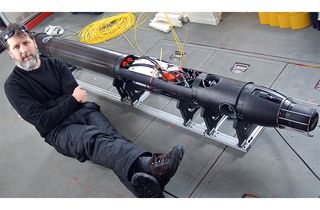How NASA Could Explore Jupiter Moon Europa's Ocean

Europa is an ice-covered moon orbiting Jupiter that likely hosts an undergound ocean. Perhaps that ocean contains life. Perhaps it doesn’t. But we’re not going to know for sure until we send a probe there to check things out.
NASA announced last week that it’s one step closer to flying by Europa dozens of times after launching in the 2020s. The mission concept was approved and funding is ongoing. To get under that ice (virtually), NASA could include a radar instrument called REASON(Radar for Europa Assessment and Sounding: Ocean to Near-surfaces). But what if we were to eventually send a robotic landing mission?
NEWS: NASA’s Europa Mission to Hunt Down Life’s Niches
Britney Schmitt, a member of the Europa mission team, told a conference last week that her team in Antarctica is testing out the very techniques that could be used at Europa, hundreds of millions of kilometers away. [Photos: Europa, Mysterious Icy Moon of Jupiter]

"Europa may seem alien to you and I, but if you go the Earth’s poles, it doesn’t seem as far-fetched," said Schmidt, who is an assistant professor in the Georgia Institute of Technology’s Earth and atmospheric sciences department.
ANALYSIS: Europa Mission Wins Big in New NASA Budget
At McMurdo Station in Antarctica last year, a mini-machine called Icefin dove under the ice to check out what’s sitting underneath the shelf. That was no small feat, given that the ice is tens of meters thick. The resulting video shows what’s lurking on the seafloor. Even to Earth-accustomed eyes, it looks kind of alien.
Get the Space.com Newsletter
Breaking space news, the latest updates on rocket launches, skywatching events and more!
Icefin (Schmidt is principal investigator) is powerful, but small enough that it can be carried by people. The tethered underwater vehicle even breaks down into pieces to make it easier to transport. The instruments on board are supposed to measure things such as the ice, what’s in layers of water and what’s living on the seafloor. It can dive as deep as 4,921 feet (1,500 meters) and is designed to travel at least 1.86 miles (3 kilometers) underwater.

And if you think that’s amazing, check out what’s swimming in the waters this summer: Artemis, a more powerful underwater vehicle that can travel up to 9.3 miles (15 km). The goal is not only to test out technologies for Europa, but to better understand the fragile environment of Antarctica and how best to protect it.
NEWS: NASA’s Europa Mission Will Look for Life’s Ingredients
Schmidt characterized the work, which is led by Georgia Tech, as key to helping with NASA’s Europa mission. "Personally, I’m proud to be a part of the mission team. I’ve helped on studies for a while, and it’s just been a large group of people working for the past 20 years to get this mission going," she said.
Schmidt spoke last Tuesday (June 16) at the 2015 Astrobiology Science Conference in Chicago as part of a panel discussion, which you can view in full here. Icefin and Artemis are part of a larger project called SIMPLE, or Sub Ice Marine and Planetary–analog Ecosystem, which is funded in part by the NASA Astrobiology Institute.
Full disclosure: The writer for this article also writes for this NASA institution.
This article was provided by Discovery News.
Join our Space Forums to keep talking space on the latest missions, night sky and more! And if you have a news tip, correction or comment, let us know at: community@space.com.

Elizabeth Howell (she/her), Ph.D., is a staff writer in the spaceflight channel since 2022 covering diversity, education and gaming as well. She was contributing writer for Space.com for 10 years before joining full-time. Elizabeth's reporting includes multiple exclusives with the White House and Office of the Vice-President of the United States, an exclusive conversation with aspiring space tourist (and NSYNC bassist) Lance Bass, speaking several times with the International Space Station, witnessing five human spaceflight launches on two continents, flying parabolic, working inside a spacesuit, and participating in a simulated Mars mission. Her latest book, "Why Am I Taller?", is co-written with astronaut Dave Williams. Elizabeth holds a Ph.D. and M.Sc. in Space Studies from the University of North Dakota, a Bachelor of Journalism from Canada's Carleton University and a Bachelor of History from Canada's Athabasca University. Elizabeth is also a post-secondary instructor in communications and science at several institutions since 2015; her experience includes developing and teaching an astronomy course at Canada's Algonquin College (with Indigenous content as well) to more than 1,000 students since 2020. Elizabeth first got interested in space after watching the movie Apollo 13 in 1996, and still wants to be an astronaut someday. Mastodon: https://qoto.org/@howellspace
